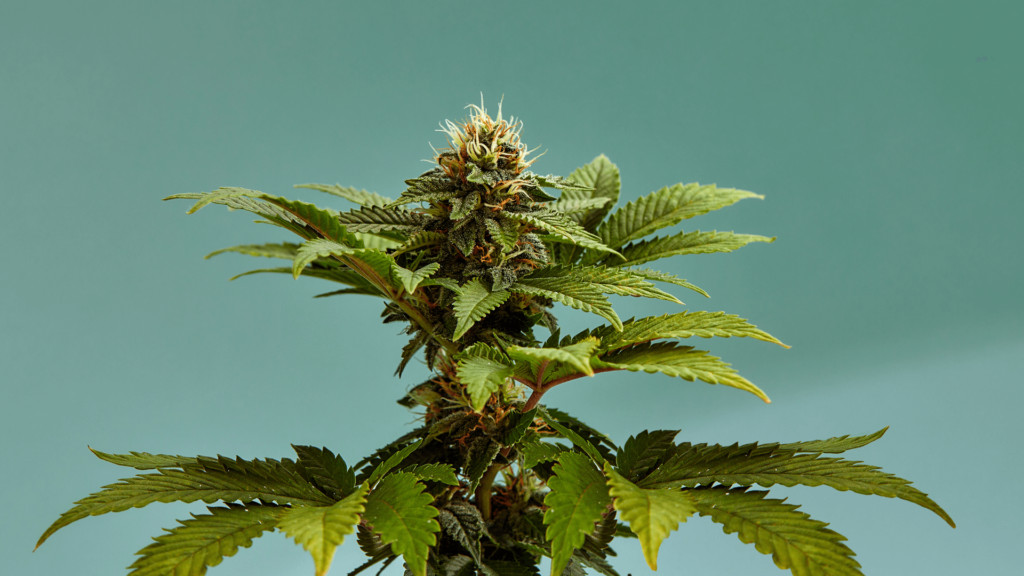Ever wondered if cannabis could thrive in extreme conditions? Nature has a way of surprising us, even in the most challenging climates. This resilience is noticeable in the realm of cannabis cultivation, particularly with the emergence of auto-flowering strains, designed to flourish in northern regions.
But how did these unique strains come about, and what sets them apart? If you’re curious about the world of auto-flowering cannabis and its benefits, you’re in the right place.
In this article, we explore the fascinating process of producing auto-flowering strains, their advantages and potential drawbacks, and provide essential tips for successful cultivation.
Whether auto-flowering cannabis is the right choice for your needs, we’ll help you make an informed decision.

Outdoor cannabis plants grown from regular seeds flower (produce buds) as fall approaches. The reduction in daylight, because of an earlier sunset, triggers the flowering phase.
This is normal for cannabis plants. Indoor growers mimic this natural flowering cycle by manually reducing their daily exposure to light from 18 to 12 hours. However, there is a subspecies of cannabis called cannabis ruderalis, that developed millennia ago in extreme northern European and Asian regions.
It adapted to the harsh climate with its brief summers, flowering after a certain amount of time, rather than responding to seasonal daylight-hours cues. Its ability to flower automatically, despite a lack of clear seasonal indicators, earned it its name. ‘Auto-flowering cannabis’.
This cannabis variety typically contains a much lower concentration of the psychoactive compound tetrahydrocannabinol (THC) than other cannabis varieties. The upside is that it often has higher cannabidiol (CBD) levels.
You can create auto-flowering strains by crossbreeding indica or sativa plants with the ruderalis variety of cannabis.
This gives one the best of both worlds – the shorter growing time of ruderalis, plus the higher THC concentration of indica and sativa. There are now auto-flowering versions of many popular cannabis strains.
An auto-flowering cannabis plant does not rely on a seasonal daylight cycle to trigger its flowering cycle. Instead, it flowers automatically after a specific time has elapsed.
The lifecycle of this cannabis variety is short. Some auto-flowering strains can mature in as few as six weeks, while others take about twelve. But the average time taken to produce a harvest from seed is typically eight to ten weeks.
Like other varieties, it goes through successive stages – germination, seedling, vegetation, pre-flowering, and the flowering stage. They just reach each stage sooner than other cannabis plants.
The germination and early seedling stages take just one week, followed by the late seedling stage in two weeks. During weeks three and four, auto-flowering cannabis goes through a vegetative stage.
Pre-flowering begins as early as five weeks, and the flowering stage starts in earnest from as early as six weeks.
Once your plant has matured, it’s time to harvest your cannabis crop. Your particular auto-flowering strain will determine when you can start harvesting, but the plant is usually ready for harvest from weeks ten to fourteen.
Auto-flowering cannabis strains offer several benefits compared to traditional photoperiod strains.
One of the biggest advantages of auto-flowering plants is their rapid growth cycle. These strains have a shorter life cycle, from seed to harvest, ranging from eight to twelve weeks. This quick turnaround makes them an attractive option for growers looking to harvest multiple times within a single growing season or those seeking a faster harvest overall.
One of the biggest problems of indoor cannabis growing is the need to control the growing environment. This includes a strict regimen of light and dark, as well as other factors like temperature, airflow, and humidity.
Auto-flowering plants are less sensitive to light cycles, allowing for more flexibility in lighting setups and potentially reducing energy costs for indoor growers.
Cannabis plants need nurturing, just like any other plant species. This includes mimicking their ideal growing environment and supplying vital nutrients for growth and development. Auto-flowering strains are adept at growing in less-than-ideal environments and thus can grow with fewer nutrients.
Another significant benefit of auto-flowering cannabis is its resilience to pests and diseases. Because of their rapid growth cycle and sturdy genetics, these strains are less prone to pest infestations and disease outbreaks compared to photoperiod strains.
This resilience can save growers time and effort in pest management and reduce the need for chemicals, offering a more natural and sustainable growing approach.
One of the top benefits of auto-flowering cannabis seeds is the potential for a bigger harvest. It’s the seed that can give you more weed, with much less hassle. Auto-flowering plants are typically smaller and take up less space than other varieties. But certain crossbred strains produce bigger than usual yields.
Who doesn’t want more weed with less stress? Because auto-flowering cannabis strains are fast-growing, you can enjoy more mature crops each year than you would with other cannabis plants. Now you don’t have to wait so long to enjoy the fruits of your labor!
Learning to grow cannabis, especially indoors, usually involves a lot of trial and error. But auto-flowering cannabis seeds make it a lot easier. Because they are so hardy, low-maintenance, and fast-growing, these plants are great for inexperienced beginner growers.
It’s not all good news, though.There are some disadvantages to growing auto-flowering cannabis.
Are you keen on growing your own auto-flowering cannabis? These tips will help you on your way.
Auto-flowering strains differ in the time taken from seed to harvest. The average time is eight to ten weeks. However, some can take longer, such as the ‘Royal Creamatic’ and ‘Royal Haze Automatic’ strains. ‘Quick One’, as the name suggests, as well as ‘Bubble Cush Automatic’, reach harvest time faster.
It’s important to use soil that is pest and pathogen-free. But don’t forget the PH value. This plays a significant role in how well cannabis plants access the nutrients within.
Auto-flowering strains are hardier and can develop and grow with minimal nutrients. However, this does not mean that you should use poor-quality soil. Cannabis thrives in soil with a pH of between 6.0 and 6.5.
You can grow your auto-flowering cannabis either outdoors or indoors. People usually favor outdoor growing for these plants because of their powerful smell.
Outdoor cannabis growing is also more cost-effective than indoor growing. That said, indoor cannabis growing allows you greater control over the growing environment.
Hermaphrodite plants, or ‘hermies’ as growers typically refer to them, are a big problem for cannabis cultivation. These plants have both male and female characteristics, and once pollinated will focus more on seed production than budding.
That’s not conducive to harvesting a good crop of weed. Remove these plants from your crop as soon as you detect them, as they can contaminate other nearby plants.
Auto-flowering cannabis strains don’t require a change in the light cycle to enter their flowering stage. That’s their biggest benefit, after all. However, many growers keep to a light schedule of eighteen hours on and six hours.
Others, still, keep their lights on around the clock to optimize photosynthesis and growth rate. You may find that heavy on the power bill, though.
If you have used heavy doses of nutrients to boost growth and development throughout its lifecycle, your cannabis buds may have a harsh taste when smoked.
Avoid this by ‘flushing’ your crop. Stop using the nutrients seven to ten days before harvesting. Use plain water, and pour through until some of it drains out of the growing container. Learn more about watering and flushing cannabis plants, here.
Auto-flowering cannabis can reach the harvesting stage much sooner than other cannabis varieties. Observe its trichome development and watch out for milky white trichomes. This signals peak THC levels.
The pistils (hairs) will usually change to a brown or orange color during flowering. Once 70-80% of the pistils have changed color, your plant is ready for harvesting.
Thanks to the clever cross-breeding of the ruderalis sub-species with other cannabis strains, everyone can enjoy auto-flowering cannabis. This offers some distinct advantages for first-time cannabis growers, too, such as faster growth and more resilience.
But if you want an even quicker path to weed enjoyment, there’s Embarc. You’ll find a great variety of cannabis products in our dispensaries, from high-quality flower to premium concentrates, edibles, and topicals. Browse our extensive catalog of cannabis products today and find the right one for you.
